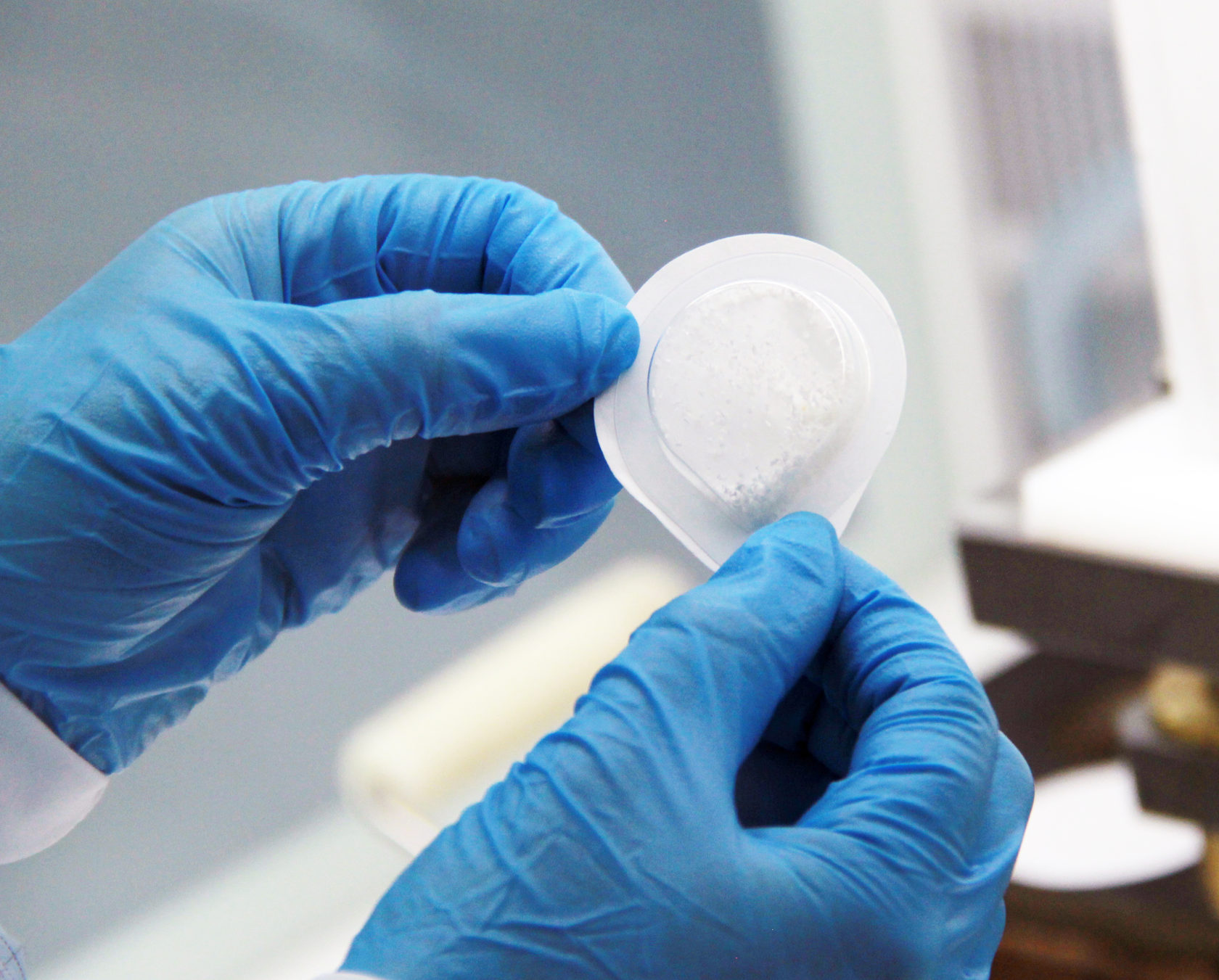NATURAL OSTEOPLASTIC MATERIAL
OSTEOPLASTIC MATRIX "Bio-Ost"
Osteoplastic matrix
"Bio-Ost"
"Bio-Ost"
Size
Osteoplastic matrix in the form of granules of different sizes and volumes. Natural osteoplastic material. A mixture based on spongy and cortical bone tissue with collagen to fill in bone defects of vertebral bodies.
Small granules are designed to fill small defects, complex narrow areas or to fill large defects in combination with other materials. Medium-sized granules are mainly used for filling medium and large cavities. After implantation a bimodal porous structure is formed (an open porous structure with a pore size of 200-500 μm for sprouting into the material of bone cells and vessels and micropores less than 100 μm for interstitial body fluids) of bone tissue. The rate of resorption depends on the properties of the patient's receiving bed and can range from 6 to 16 months, which corresponds to the rate of physiological replacement of the defect. The size of granules from 1 to 4 mm allows to fill defects of complex shape as effectively as possible, because smaller granules are able to fill all complex terrain areas, providing maximum contact with the recipient's bone, and larger granules maintain the necessary volume of the matrix. In addition the combination of spongy bone granules with cortical, which has a different rate of resorption, allows for good angiogenesis.
Graft after implantation retains the necessary strength and volume, later being rebuilt into bone tissue. This eliminates the "shrinkage" of the regenerate. The matrix in the form of granules consists of separate fractions of the spongy and cortical layer of bone, which provides both a pronounced osteoconductive effect and background osteoinductive properties. The presence of cortical granules in the product ensures long term preservation of volume and seals the defect.
Small granules are designed to fill small defects, complex narrow areas or to fill large defects in combination with other materials. Medium-sized granules are mainly used for filling medium and large cavities. After implantation a bimodal porous structure is formed (an open porous structure with a pore size of 200-500 μm for sprouting into the material of bone cells and vessels and micropores less than 100 μm for interstitial body fluids) of bone tissue. The rate of resorption depends on the properties of the patient's receiving bed and can range from 6 to 16 months, which corresponds to the rate of physiological replacement of the defect. The size of granules from 1 to 4 mm allows to fill defects of complex shape as effectively as possible, because smaller granules are able to fill all complex terrain areas, providing maximum contact with the recipient's bone, and larger granules maintain the necessary volume of the matrix. In addition the combination of spongy bone granules with cortical, which has a different rate of resorption, allows for good angiogenesis.
Graft after implantation retains the necessary strength and volume, later being rebuilt into bone tissue. This eliminates the "shrinkage" of the regenerate. The matrix in the form of granules consists of separate fractions of the spongy and cortical layer of bone, which provides both a pronounced osteoconductive effect and background osteoinductive properties. The presence of cortical granules in the product ensures long term preservation of volume and seals the defect.



- filling in bone defects
- interbody spondylodesis
- vertebral fractures and injuries

The product is available in a convenient form for the doctor – a double sterile blister pack, the inner blister of which serves as a tray for preoperative preparation of the material.

Osteoplastic matrix is used in neurosurgery to fill in defects of bone tissue, spondylodesis of vertebral bodies and other reconstructive and reconstructive operations. The bioOST matrix is a purified sterile bone tissue of young cattle that has passed strict veterinary control. Depending on the residual content of the inorganic phase, the osteoplastic matrix is produced demineralized (with a reduced mineral content) and non-demineralized. During demineralization native bone growth factor proteins sewn with hydroxyapatite open, which provides background osteoinducing properties of the matrix. As a result the mineral-collagen matrix demonstrates both osteoconductive and osteoinductive properties, which allows us to achieve the highest quality results when replacing bone defects. Non-mineralized matrix has osteoconductive properties and high enough strength. When used as an osteoplastic material, it allows you to form the necessary volume of bone regenerate.
The bone matrix of different fragmentation and different behavior can solve any clinical problem.
The bone matrix of different fragmentation and different behavior can solve any clinical problem.

We have conducted a detailed analysis of the world's experience in processing allogenic and xenogenic bone tissue. Despite the existence of dozens of methods for manufacturing osteoplastic materials, the number of approaches to processing bone tissue is limited. This is either the use of high temperatures (firing) or the use of "hard" organic solvents to remove fat, or the use of vacuum technologies for physical cleaning of the matrix. There are also combinations of similar techniques. Each approach has advantages, but it also has disadvantages related to the parameters of the final product.

The technical specification for the development of our method of manufacturing osteoplastic material is based on such characteristics of the biomaterial as the degree of purification, the presence of residual chemical agents, the presence and state of collagen and native growth factors, osteoconductive and osteoinductive properties of the product and thermal reconstruction of hydroxyapatite.
The developed and patented raw material cleaning technology allows removing any type of antigen from the bone material without affecting the biological and mechanical properties of the native bone tissue. Raw materials at the stage of degreasing and cleaning are subjected to unique processing using the latest physical and chemical methods at physiological temperatures. In this case, lipids and intercellular substance are completely removed, and bone microporosity becomes available. This makes it possible after the demineralization stage to release collagen and native protein growth factors, which are the most important supporting proteins and osteoinductive molecules that provide physiological bone regeneration.
The developed and patented raw material cleaning technology allows removing any type of antigen from the bone material without affecting the biological and mechanical properties of the native bone tissue. Raw materials at the stage of degreasing and cleaning are subjected to unique processing using the latest physical and chemical methods at physiological temperatures. In this case, lipids and intercellular substance are completely removed, and bone microporosity becomes available. This makes it possible after the demineralization stage to release collagen and native protein growth factors, which are the most important supporting proteins and osteoinductive molecules that provide physiological bone regeneration.
- deep cleaning of biotissue from fats, proteins of intercellular substance, as well as from possible viruses
- formation of an open porous system of the bone matrix
- the maximum reduction of immunogenicity, enhancement of biocompatibility
- preserving the natural bimodal porous structure
- preservation of native protein growth factors
- possibility of incorporation by recombinant protein factors
- use of safe reagents that do not affect the toxicity of the implant
The developed raw material processing protocols make it possible to produce biomaterials with different physical, mechanical and behavioral properties. Among the offered products, you can find a product that is necessary for solving individual tasks of any complexity.
